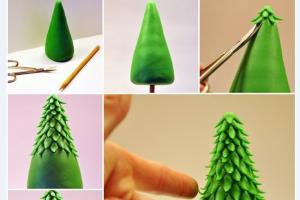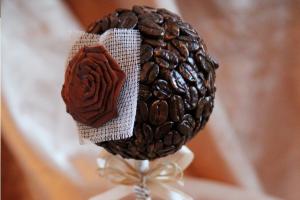Polyurethane foam – unique construction material, which is widely used for installation, sealing of structures and increasing their thermal insulation. Lovers of garden decorations have expanded the scope of application of this building material. Garden figures from polyurethane foam Every owner can easily do it with his own hands country house or a summer cottage. In this article you can see photos of finished crafts, as well as popular sculptures made from polyurethane foam.
1. Light weight.
2. Ease of use (applied to any surface, easy to cut).
3. The ability to make crafts of any size.
4. The finished product is not affected by precipitation and temperature changes.

Conditions for using polyurethane foam for garden sculptures
Conditions for using polyurethane foam for garden sculptures
If you have never worked with polyurethane foam, we recommend that you read the instructions from the manufacturer. Do not forget that the foam inside the container is a liquid mass, and when it comes into contact with air, it begins to harden. Complete hardening occurs after 10-12 hours. When working with foam, use personal protective equipment. It is not recommended to carry out work when sub-zero temperature air.
Before each use of the foam, shake the container well. While working, keep the can with the cap down so that gas does not escape from it and all the foam can be used. You should not apply many layers at once, as the uncured ones will fall off. Do everything gradually, apply the next layer at least 10-15 minutes after the previous one. For ease of application, use a special gun.
The appearance of a polyurethane foam figure directly depends on the type of frame. You should first find a picture of the figure or make a sketch so that all the nuances are taken into account and the finished product looks like a wooden or plaster sculpture.

To make the frame, you can take different materials, for example, plastic bottles or iron cans are suitable. Wooden planks, fittings and wire will also be useful to you. To make the sculpture stable, you need to fill it with sand.

Now you can start decorating the craft with foam. Distribute the foam evenly over the frame, taking into account the future reliefs of the craft. When it has completely hardened, you can remove it with a stationery knife. unnecessary details and correct defects. If necessary, add foam to places where you forgot or want to correct something in the craft.

A layer of putty will help protect the mounting foam from destruction. To make the garden craft smooth, grout sandpaper. Now take acrylic paints and cover the figure. Preferably two layers or more. To extend the service life of the future masterpiece, it is coated with varnish on top.

Garden figures can be additionally decorated with the most different materials, for example, beads, flowers or make LED backlight so that the sculpture glows at night.

In order to make a snail for the garden, you will need half a bottle of foam. Cover the table with oilcloth and begin applying foam for the base of the snail. When the first layer has dried a little, apply the second and insert a kefir bottle to make the snail's neck. Cover your neck with foam too and form a head with your hands.

Give the snail horns and a slightly elongated muzzle. After this you can start making the shell. To do this, a round mound of foam is applied to the snail's body. Now insert a bucket, which will be intended for flowers and will turn the garden craft into an original flowerbed.

Use a marker to mark where your snail shell begins and ends, and make curls. When the foam is completely dry, sand the product. All that remains is to decorate the snail and the garden craft is ready.

Materials:
- old saucepan;
- can:
- oil or acrylic paint;
- foam container;
- wire;
- beads.
1. Separately fill the pan and jar with foam and let dry.
2. The jar is the head, and the pan is the body of the frog. Fasten these parts with wire and secure with foam.

3. In the place where the frog’s arms should be, secure the wire and also cover it with foam.
4. Now shape the head and body so that they look like a frog. Make the lower legs as well.
5. Paint the craft with paints and then insert the eyes. The frog is ready, now it can be placed near a pond in the garden or near the pool.

To make a garden fox figurine, you will need plastic bottle. Fill it with sand or pebbles, then the wind will not be able to turn your product over. Foam the bottle, but not immediately in a thick layer, but gradually, pausing for about 15 minutes for the foam to set.

You can use a rubber tube to make the paws. To make the legs flexible, insert a wire into the tube. The tail can also be made from a tube, which will need to be well foamed. For the neck, use a cardboard toilet paper cylinder. Install some kind of round blank for the head.

Foam everything well and give it to the sculpture appearance foxes. After that, paint the figure oil paints and varnish. Keep in mind that if the paint is white, the varnish will make it yellow.

You can use a plastic ball as the frame of the kolobok. Place it on some kind of support, such as a jar or bowl. Now apply the foam, waiting for each layer to dry. To make handles, insert wire.

Also form the scarf from foam, and you can make the ears from cardboard. When the foam is completely dry, use a utility knife to cut out the eyes, mouth and nose. Make legs from wooden planks. All that’s left is to color the craft and the bun – it’s ready!

Interestingly, from polyurethane foam you can make not only garden figures, but also an original lantern that will give your personal plot notes of exclusivity and will help decorate the garden in Japanese style. To make a lantern stand, take a pipe that needs to be foamed on the bottom side and installed on a level surface. wooden base. For the lantern bowl, you can use a plastic bowl that needs to be secured on top.

Now pour the foam in layers, waiting for each layer to partially dry. Come up with a design to decorate the lantern, draw a diagram and implement the idea using polyurethane foam. You need to make a hole in the center of the bowl so that you can secure the lid with self-tapping screws. Insert the bars into the bowl and foam them.


Attach the lid to the bowl with self-tapping screws. Now cut out a smaller square from the chipboard. Foam it on one side and secure the racks on the other. You need to make a hole in the center of the squares to then insert a solar-powered lamp into it. Hide the wires.

After that from big piece The roof is made of plywood, which is installed on racks. To make the relief design beautiful, first draw it with a marker on the surface of the lantern, and then carefully cover it with foam.

Garden figures made of polyurethane foam master class
The finished product is completely painted. To install it, you need to dig the pipe a little into the ground or make a small flower bed around the lantern.

DIY polyurethane foam figures will help transform any garden plot. Even without the skills of a sculptor and artist, you can make a beautiful sculpture that will enliven your exterior.
polyurethane foam can also be used to decorate rooms or building facades.
Polyurethane foam is a practical and convenient thing. It is very easy to use and process. Besides, foam doesn't cost that much money. And most importantly, it is often found in everyday life in the form of surplus or leftovers. And if after construction is completed, crafts for the garden will become accessible and simple. The main thing is to have imagination and some ability to work with a knife.
To make crafts from polyurethane foam with your own hands, we will need:
- Foam. Depending on the size of the figure, up to ten cylinders may be needed.
- The basis. An object on which the foam will be built up (suitable in shape).
- Knife. It is best to take a sharp and thin one; it would be preferable to use a scalpel.
- Paint, varnish.
Planning
First, you need to clearly imagine the size and shape of the figure, which will represent future crafts made from polyurethane foam with your own hands. You need to proceed only from your own desires; other factors have little influence on the result. After this, the base is selected. You can use any fairly hard objects - bottles, pipes, cardboard, wood, and so on. If the figure will stand on the street, it is better to make the frame relatively heavy so that the creation is not blown away by the wind and falls. It is also worth preparing workplace, where you will create crafts from polyurethane foam with your own hands - lay it out or in a workshop, stock up on solvent (to wash your hands after finishing work) and gloves.

Foam coating
We begin to cover the assembled and prepared frame with foam. This needs to be done layer by layer, giving each layer ten to fifteen minutes to dry. Attention! Before being coated with paint, the foam is very susceptible to direct sunlight, which can adversely affect its properties, so it is best used indoors closed windows. After application, you can adjust. Some frame parts are attached to it separately after applying several layers of foam. It is also possible to create entire individual parts, coat them and attach them to the main figure using the same material as glue. It is only because of drying that crafts made from polyurethane foam take quite a long time to make with your own hands.

Decoration
After creating the completed form, you can begin design. The main option is to cover it with several layers of paint. First two, then, after several hours of drying, when the yellowness of the foam appears, one more. For durability and color preservation, it can be coated with clear varnish. The best fit is it doesn't turn yellow. Another technique is to paste over toilet paper and color it. It's easier and doesn't require a lot of paint.
Application
Crafts made from polyurethane foam, photos of which are easy to find on the Internet or in relevant magazines, are easy to make and beautiful. Any fantasy can come to life, turning into incredible and bizarre forms. Among other things, they are also incredibly functional - craftsmen use foam to create anything from lanterns to fountains. Foam can easily reveal anyone's abilities. The main thing in this matter is to clearly understand what should happen in the end and get closer to the result with every step.
Without any special effort or material costs, foam crafts will become an excellent decor and decoration for any summer cottage. It is no secret that for many, a dacha is a place where people come to relax from the city noise, rhythm and bustle. Therefore, it is very important that the dacha be exactly the place where a person can truly enjoy life and rest his soul. Often, caring for a summer cottage and decorating it requires considerable Money, patience and time, but with foam everything is different.
In order to make any crafts from polyurethane foam with your own hands, you do not need to have any special education - absolutely everyone can cope with this task, it is enough to have good imagination and imagination.
In construction, polyurethane foam is used very often and in large quantities. It is used to seal small cracks and has the ability to expand, filling all the voids.
Important! The hardening of the foam depends on what brand of foam it is, but on average it takes from 15 to 25 minutes.

You can cut off excess parts of finished products only after the foam has completely hardened.
You can cut off excess parts of finished products only after the foam has completely hardened.
From construction foam you can make any crafts, since foam is an unpretentious material, and when frozen it can withstand any temperature; in addition, crafts made from foam do not undergo any serious changes when they are exposed to precipitation.
The material is light and has no sharp corners, so foam crafts for installation are often made for kindergarten or sites. Such crafts can be either large or small in size, but the weight of the craft will be light.

When working with polyurethane foam, you must use a foam gun, which is placed on the can, and after finishing work, use a gun cleaner
How to work with polyurethane foam?
To work with polyurethane foam, you may need a minimum set of tools and accessories - several pairs of gloves, preferably rubber - the fact is that the foam has such unpleasant properties, it quickly sticks to your hands, so it is simply impossible to do without gloves. In addition, you will need 2 or 3 knives of different sizes - they are needed after the foam has dried in order to give the products the necessary shape and for cutting small parts, such as eyes, nose, mouth. When working with polyurethane foam, you must use a foam gun, which is placed on the can, and after finishing the work, use a gun cleaner. To paint finished products you will need paints and brushes. In order for foam crafts to last as long as possible, it is recommended to coat them with varnish.
Important! Polyurethane foam is a very light material, so every time before performing any new craft, it is important to take care of its weight, otherwise the structure will not hold.
Therefore, it is necessary to place something heavy inside each structure - it could be a container with sand, a piece of iron, a plastic bottle with water. You can use anything, the main thing is that the thing at least slightly fits the shape of the future craft (if the finished product is small in size or volume) and is weighty.
It is important to remember that all work performed with polyurethane foam should be carried out only in a well-ventilated area. The temperature should be room temperature. If work is carried out in the fresh air, then this should be done in good weather, but you can’t work in direct sunlight; you need to move into the shade.
While working, it is important not to forget to shake the can of foam before each use.
Finished products made from polyurethane foam must be coated with paint, but it is important to remember that the content of nitrocellulose is unacceptable, since this substance adversely affects the foam; as a result, the craft softens and the entire structure may lose its shape.

Hedgehog figurine made of polyurethane foam
Crafts made from polyurethane foam
Animal figures are especially popular among crafts made from polyurethane foam. You can place them in any part of the garden, placing a lonely figurine by the pond or on the lawn, or create an entire composition. When making crafts from polyurethane foam for kindergarten, figurines of fairy-tale characters are mainly created:
- Hedgehog. This figurine is very easy to make and is ideal for beginners. Any material can be used as a frame, it all depends on the preferences of the master. When the foam has hardened, use a knife to carefully cut off all excess and give the product the desired shape. Hedgehog needles are made from toothpicks, which must first be prepared for work - they need to be painted black, leaving a small distance untouched. The part that needs to be stuck into the figure remains unpainted. If desired, the other end of the toothpick can be painted golden. Before sticking toothpicks into the hedgehog, the figurine must first be painted and allowed to dry. In these photos you can see step by step production crafts made from polyurethane foam like a hedgehog.

Foam goat
- Sheep and lamb. A master class on making crafts from polyurethane foam, such as a ram and a sheep, should begin with making a frame. The frame can be made from several plastic bottles connected with tape. In order for the structure to be stable, the bottles that will be used as lower limbs, need to be filled with sand or water. After the frame is completely ready, you can begin the main work - treating it with polyurethane foam. Foam treatment should be done gradually, in layers. Each applied layer must dry thoroughly (15-20 minutes), and only then can the next one be applied. What the craft will look like after final processing becomes visible after the first layer. After the final layer has been applied and dried, you need to use a knife to give the figure its final shape, and then paint it.
- Goat. These photos show step-by-step instruction on making such a craft with your own hands from polyurethane foam, like a goat. For the body frame you need to use plastic bottles, pre-wrapped with tape or wire. Leftovers are used for the leg frame metal pipes, which must be the same length and thickness. The resulting structure must be securely fastened to the ground, and care must be taken to ensure that the base of the body is securely fastened to the legs. The product is covered with one or two layers of polyurethane foam. In order to make the horns and tail, you can use cuttings of thick branches, securely fasten them and apply another layer of foam to the goat. Before painting the goat you need to apply one thin coat of primer. Large buttons can be used to make eyes.

Polyurethane foam bun
- Kolobok. This photo shows a craft in the form of a kolobok, made with your own hands using polyurethane foam. A medium-sized plastic ball can be used as a frame. The ball needs to be covered with foam in several layers, not forgetting to dry each layer. The hands of the kolobok are made of a plastic tube with a wire stretched inside. Hands need to be secured to the kolobok and treated with foam. Small ones are used for the legs wooden blocks, which must also be secured and foam applied to them. The scarf is also made of foam. And you can use cardboard as a frame for the ears on the headscarf. The finished bun needs to be painted, varnished and planted on some stump.
- Figure for growing flowers. In order to make an original flower pot, you can make any craft from foam. But it is important to remember that in the middle part of the figure you need to secure a container for growing flowers - this can be: a deep basin, a tin bucket, a large plastic bottle with a cut neck.
- New Year's crafts. Such foam crafts can be made either on summer cottage, and on the territory of the kindergarten. A Christmas ball can be made from a tennis ball; to do this, cover it with a layer of foam and paint it with bright colors.
In order to make a Christmas tree, you must first make a frame. The frame is made from a cone made of cardboard. The foam is applied in several layers to the cone-shaped frame. As it dries, the figurine is shaped into a Christmas tree using a knife and painted in the appropriate color.
It is not at all necessary to spend money on purchasing ready-made garden figures to decorate your site. Original crafts made of polyurethane foam will become a worthy element landscape design. The main thing is to show imagination and a little perseverance.
Properties of polyurethane foam
The scope of application of polyurethane foam is quite extensive. Now it has spread to the landscape design of the site. Garden figures created with your own hands from polyurethane foam are no worse than specimens made on a production scale, and are often superior in decorativeness to crafts made from tires or plastic containers.
The special properties of polyurethane foam allow you to create crafts of complex shapes. Ease of processing makes creative activity accessible to weak women's or children's hands. In the process of forming a garden figure with your own hands, removing an extra fragment or adding a missing part will not be difficult. With proper decoration, the craft looks very presentable and does not show traces of recycled materials, as is the case with plastic containers.
Attention! Garden figurines made from polyurethane foam are resistant to precipitation, but require protection from ultraviolet radiation.

An obstacle to creating crafts with complex configurations may be a lack of experience working with three-dimensional figures. Creating something new from scratch, focusing only on a flat image, is a problem for some. Therefore, it is initially recommended to practice on simple garden figures. Mushroom, turtle or ladybug will be an excellent start for demonstrating the abilities of a sculptor.
Depending on the volume of foam used in the manufacture of the craft, it may take considerable time for it to dry completely. Usually the process lasts for a week. You should be prepared that polyurethane foam in the process of forming a garden figure can pollute the surrounding area, so it is recommended to organize work in an open area.
Colorful examples of do-it-yourself polyurethane foam figures are presented in the photo:


Available materials
The list of available materials varies depending on the garden figure chosen for making, but the constant set consists of the following items:
- Polyurethane foam. It is better to replace a regular can with a tube with a pistol, which is much more convenient to work with.
- A stationery knife for trimming unnecessary elements.
- Latex gloves to protect your hands. Fabric products will quickly become unusable.
- Sandpaper for sanding the surface.
- Brush with paints intended for external use.
To create the frame of a craft, they usually use plastic containers and cans, rigid wire, planks, hoses and double-sided tape. If foam gets on your skin during work, a special cleaner or kerosene will help get rid of the dirt.
Advice! A garden figure made using polyurethane foam is lightweight, so at the formation stage measures are taken to make it heavier. Plastic containers can be partially filled with sand or small pebbles. The wire protruding from the paws of the animals will help to fix the craft on the ground.

General algorithm
Preliminary familiarization with the instructions for using polyurethane foam will reduce the likelihood of undesirable situations developing. Making crafts should be done on outdoors at positive temperatures. If work is carried out indoors, it is worth taking care of quality ventilation. Polyethylene film will prevent contamination of the surface, the mounting foam will not stick to it.
Shake the can before use and keep the cap down when working. Otherwise, the gas will escape and the material will not be completely consumed. The polyurethane foam gains initial strength within an hour and completely dries in 10 hours. It all depends on the applied layer.
Apply in one go a large number of material is not recommended, the liquid substance may fall off. The optimal way to organize the work of forming a garden figure is as follows:
- position the frame of the craft horizontally;
- apply a small layer of foam;
- give the material time to dry;
- turn the craft over and repeat the steps.
When the foam dries again, the voids and missing fragments are filled in accordance with the selected outlines of the garden figure. Excess fragments are removed with a sharp stationery knife. To achieve flat surface crafts, it is sanded with sandpaper attached to a block.

Advice! Putty can protect a garden figure from rapid destruction under the influence of sunlight. This technique will provide additional leveling of the surface.
After the composition has completely hardened, the decorating stage begins. Usually it consists of painting a figure from polyurethane foam. Acrylic-based paints, which are applied in 2 layers, are optimal for the job. Additional decorations include buttons, cords, mustache wire, and pieces of glass to create a mosaic.

Typical crafts made from polyurethane foam for the garden
Studying a wide range of garden objects made using polyurethane foam, we can roughly distinguish two groups of crafts. In one case, the surface of the figures is smooth, in the other it is lumpy and often imitates the skin of an animal.

Leveled areas are often additionally covered with putty. This creates a protective layer against UV rays. This technique is not used with rough garden figures.
It is unlikely that it will be possible to achieve the identity of an animal skin immediately after applying the foam; this will require additional manipulations. But the result of painstaking work is always impressive. The only exception may be the lamb, whose curls are so similar to the lumpy surface obtained from a liquid construction substance. Vivid examples of DIY crafts made from polyurethane foam are shown in the photo:


Representatives of the animal world are the most popular solution when creating garden figures. Less often they create objects of inanimate origin - all kinds of flowerpots, shoes and other objects, mainly intended as decorative stands under the flowers.

Simple crafts
If you have no or insufficient experience in creating crafts, it is better to start the experiment with a light garden figure, for example a mushroom, the base of which is a plastic bottle. You will need to add a primer to the previously listed available materials and you can begin to get creative.
Main stages:
- A plastic bottle, which acts as a stem, is filled with sand or pebbles to give the mushroom stability.
- The mounting foam is distributed in a thin layer, the process takes place in several stages. A thickening is formed in the lower part.
- The garden craft hat is cut out of polystyrene foam. There is no point in striving for a perfect circle; slight asymmetry is quite acceptable.
- You should try to form a cone-shaped figure or hemisphere from the polyurethane foam applied to the foam.
- Strong wire is used to connect two parts of a garden figure. Gluing the parts will help strengthen the fixation.
- Trimming of unnecessary protruding parts is carried out carefully so as not to damage the assembled craft.
Comment! The porosity of the polyurethane foam causes moisture to be absorbed, so it is recommended to treat the garden figure with a primer.

The absence of a primer layer will lead to the putty absorbing moisture from the polyurethane foam, this process will provoke cracking of the surface of the craft. After primer garden figure covered with a layer of putty and left to dry. To make the mushroom smooth, the surface of the garden figure is treated with sandpaper, first medium-grit, then fine. To reduce paint consumption, the putty surface also needs to be coated with a primer layer. The color of the craft is chosen at your discretion, whether it will be cute White mushroom or bright fly agaric, depends on the wishes of the master. Varnish can add additional shine to the figure.

Large figures
When simple do-it-yourself polyurethane foam figures turn out quite well, the task of creating garden crafts you can complicate it and move on to larger objects.

Donkey
To form a popular element of landscape design you will need:
- A 10 liter water container will serve as the body of a garden figure.
- A 5 liter tin can or eggplant will act as a muzzle.
- Wooden planks for feet.
- The glazing bead or wire will become the basis of the tail of the garden figure.
- A familiar set of tools that are used when making crafts from polyurethane foam.

When everything is prepared, begin the creative process:
- First, connect two containers together; wire or tape will do the job.
- A glue gun will help you secure the legs to the body of the garden figure.
- The tail is inserted into a pre-prepared hole.
- The eggplant is filled with sand to give the craft heaviness and stability.
- When the frame of the garden figure is completely prepared, it is gradually covered with polyurethane foam. Take a break of 15-20 minutes between applying the next layer.
- The ears of a garden figure can be made perfectly from flexible wire, which, after fixing, is also covered with polyurethane foam.
- After drying, unnecessary protruding fragments are cut off with a sharp knife.
- Applying further layers is identical to the algorithm for creating a mushroom. First, the craft is primed, then the surface is treated with putty, then sanded, primed again and painted. The final layer will be waterproof varnish.
Naturally, between each action, the polyurethane foam craft is given time to dry out the next applied layer.


Symbol of family happiness - stork
A stork looks incredibly cute on the site, the manufacture of which will also require polyurethane foam. The algorithm of actions includes the following steps:
- A plastic 5-liter container serves as the body of a garden figure.
- The stork's head will be located on the bottom side, the tail will be in place of the neck.
- A thick wire will serve as the base of the neck, onto which the foam head is fixed.
- At the discretion of the master, the long nose of a garden figure can be made from a small piece of wire or wood chips.
- Long legs for crafts can be made from electrodes or plastic pipes. Both materials are subsequently buried in the ground, thanks to which the garden figure made of polyurethane foam becomes stable. Therefore, it is not necessary to fill the eggplant with sand to weigh it down.
- You can make wings from pieces of foam plastic. They are screwed to the sides of the craft with wire.
- Wrapping it with tape will help add additional strength to the connection between the head and the body.
- When the frame of the garden figure is completely assembled, they begin to cover it with polyurethane foam.
- After complete hardening, excess fragments are removed with a stationery knife with a sharp blade.

When the polyurethane foam is completely dry, proceed to decoration. As a primer for a garden figure, you can use an aqueous solution of PVA glue, diluted in a ratio of 1:2. The body and head of the craft are covered with white paint, the tail and edging of the wings are made black, and the legs of the stork are painted red. For the stork's tail, you can use real feathers from poultry, be it a goose or a rooster. When the garden figure is completely ready, the legs of the stork are buried from electrodes into the ground.

Review of original ideas
The choice of garden figures that you can create with your own hands using polyurethane foam is unlimited. Here is a modest list of original ideas:
- A small artificial pond or waterfall will be perfectly decorated with a funny frog or turtle. Someone might want to become the owner of a crocodile or a monitor lizard - it all depends on preferences.
- If children are relaxing on the site, they will like the presence of a craft in the form of a cheerful SpongeBob.
- Bright ladybugs always attract attention.
- Polyurethane foam will not require sanding if a lamb is chosen as a garden figure.
- Sometimes a wire with which plastic containers are braided and then gradually filled with foam helps to create a frame with a complex configuration.
- The craft does not need to be coated with paint. Some masters of working with polyurethane foam offer to create a real mosaic on a garden figure from small pieces of mirrors or tiles.
In the process of creating any craft, it is important to let each applied layer dry thoroughly. This applies not only to polyurethane foam, but also to primer, putty and paint. If technology is violated, a garden figure can quickly become unusable.

Polyurethane foam has firmly won its place in the construction industry. This convenient sealant can relieve installation work and the range of its applications is unusually high. But now, increasingly, polyurethane foam has begun to receive unusual use as a material for creating crafts. To figure out how to do this, you must first know what polyurethane foam is and what features it has.
What is polyurethane foam and what is it used for?
First of all, polyurethane foam is effective remedy, capable of providing reliable sealing of seams and correct position installed parts. Essentially, it is a combination of two components: isocyanate and polyol, which are produced from petroleum. The foam is sold in cylinders, which, in addition to the polymer compound, also contain a propellant gas, which displaces the mixture from the nozzle. Upon contact with air, the mixture begins to significantly increase in volume and polymerization of the substance occurs.
Initially, foam found its use in ensuring reliable fixation of installed window frames and door formwork, as well as filling voids. It is characterized by the following properties:
- Significant amount of covered area. When leaving the container, the foam expands its volume, the difference of which in relation to the original is 40 times.
- Good adhesion. The foam adheres firmly to most materials, excluding only oily and polymer coatings.
- The ability to fill all hard-to-reach places.
- Ensuring a good degree of sound and heat insulation.
You need to know that foam, despite its simplicity, requires special treatment when working with it:
- foam should be worked at temperatures above +5°C,
- any work must be carried out with gloves to prevent the possibility of foam getting on unprotected areas of the body,
- Before starting work, you should thoroughly shake the container for a minute so that the contents acquire a homogeneous structure,
- the cylinder should be kept upside down throughout the entire operation, that is, with the cap down, so that the gas displacing the mixture from the cylinder can freely escape, since it is lighter than other components,
- Any products should be covered with a protective layer of paint, since polyurethane foam is resistant to direct exposure to ultraviolet rays.
- Complete hardening of the surface occurs after 8 hours; before this period the material should not be subjected to loads.
Thanks to the unique properties of the foam, many crafts made from this universal sealant began to appear.
What tools will you need to create crafts from polyurethane foam?
To begin with, you will need a simple set: the polyurethane foam itself in cylinders and a special gun for it, the cost of which starts from $5. In addition, the work will require the following tools in order to create crafts for the garden:
- stationery knife,
- art brushes different sizes: 4.8, 10 and a wide brush of 25 mm for decorative work,
- foam cleaner,
- Oil paint,
- weights. Since the foam is light in weight, only 20 kg per m³, the products should be equipped with simple weights, the role of which is played by a container with sand - a plastic bottle or a small jar,
- colorless protective varnish. Simple varnishes are not always suitable due to the fact that the resulting products will become yellowish,
- several pairs of household gloves: cotton or rubber. The latter are preferable, since household gloves sometimes provide insufficient hand protection. It is important to remember that foam is difficult to remove if it comes into contact with the skin, so the use of gloves is mandatory.
When the specified tools are prepared and the necessary supply of foam is available, the work should begin.
Where does the work of making crafts from polyurethane foam begin?
Since it is difficult to keep an artistic image of a craft in your head, you should first have photographs or pictures that reflect the essence of the future product and its prototype. Next, you will need to build a frame with a weighting agent, onto which polyurethane foam will be applied in layers. To construct the frame, plastic containers are most often used, which are filled with sand to provide weight. In addition, there is another method, structurally more efficient, when the frame for the future product is either welded from thin reinforcement with a diameter of 5 mm, or twisted from thick wire. To ensure the stability of the craft, if it is located on the ground, steel parts should be left extending 20 cm outwards. For example, if you are creating a figurine of a deer in a standing position, the rods should be threaded through the hooves.
In this way, better stability of the figurine against the wind will be achieved, and the load will be more evenly distributed across all parts of the product.
If the work on creating crafts from foam for the garden is carried out indoors, you should use a respirator. The polyurethane foam itself is not toxic, but has an unpleasant odor.
The process of creating crafts for the garden, according to novice sculptors, is not difficult. You just need to act carefully and allow the layer of foam to harden in a timely manner before applying the next layer.
Creating figures for the garden from polyurethane foam
The process of creating a figurine is technically simple. Steps to follow:
- Creating a figurine frame. If the craft is squat, then it is enough to use a plastic container with sand as a base, which, using available materials, should be adjusted to the required dimensions of the form.
- Next, using mounting gun foam is applied. The use of this tool will allow you to accurately dose the amount of material.
- Each layer should be given 20 minutes to dry.
- Using a brush and a utility knife, when the foam layer hardens, you should give the craft the required size and shape.
- After all layers of foam have been applied, and the figure has acquired finished look- it is worth plastering the entire base so that there are no cracks.
- After this, the product is painted using acrylic paints, applying at least two layers to the figure.
- At the end of the work, the figurine is varnished to ensure better preservation and resistance to weather conditions.

The finished craft should be left for several days so that all materials acquire the final degree of hardening.
Foam lamps and lanterns
A real master class can be shown by those specialists who create not only beautiful, but also functional things from polyurethane foam. Working lamps on the site will become a beautiful and eye-catching addition to the overall picture. And what’s nice is that making them is not much more difficult than a simple figurine.
To create a lamp, make a base in the form of a stool from a chipboard or OSB board, since the latter is more durable. Then the following actions are performed:
- the base is carefully foamed using a mounting gun,
- further supplemented by others wooden elements, which are also treated with foam,
- at the top of the wooden structure it is necessary to make a cover for inserting the lantern,
- after this, the upper part is covered with a layer of foam and additional decorative elements(wooden lintels, forged fittings),
- the final stage is painting the finished structure, after which the lantern is placed through the cover on the body.
If the flashlight works from solar battery, then you should secure it to the side. But this will ruin the aesthetic appearance, so you should consider installing a battery-powered flashlight.
Ready workers lighting covered with several layers of foam followed by decoration. In this case, if the lamp has an inlet power cable- you will get an aesthetically attractive design. Even if the lamp is an old model and is not distinguished by sophistication in style, such a procedure will inspire new life into an old thing.
Decorating dishes using polyurethane foam
In the event that initial skills are not enough to carry out such work, it makes sense to practice on dishes. Decorating is not difficult, just follow a few steps:
- clean the surface of the selected item from dirt,
- apply a layer of foam using a mounting gun,
- at the moment of its polymerization, use a brush and knife to adjust the resulting mass to give it a more regular shape,
- After hardening, the surface should be covered with a layer of paint.

As you can see, the process of decorating dishes does not differ significantly compared to creating a figurine. The presence of the selected dishes as an element of the base will allow you to conduct experiments without being distracted by the construction of the frame. A similar method is used for any vases, cabinets or baskets.
Creation of panels and ornaments from polyurethane foam
Polyurethane foam is also suitable for creating entire decorative panels. For example, a simple steel grate will acquire the new kind thanks to the application of foam to each of the rods, followed by the creation of artistic elements that imitate forging. With the help of a form it is quite possible to create simple decorative panels cladding, the purpose of which will be to give the building or its individual elements greater exterior attractiveness. In general, the possibility of using polyurethane foam is limited only by imagination.
Creating crafts for the garden with your own hands is not difficult. The foam itself is a lightweight and easy-to-use material, which, in addition to many advantages, is also attractive due to its price. The cost of an 850 ml container of polyurethane foam starts from $3, which allows you to special costs create entire artistic compositions. In order for the finished product to please you with its appearance, you should use several practical tips in your work:
- After the layers of foam have hardened, you should let them rest for 3-4 days. finished product to achieve maximum strength,
- For the safety and integrity of the coating, after applying several layers of paint, it is advisable to apply varnish to the coating. It is recommended to use a colorless protective varnish, since, unlike conventional varnish, it will not give the painted products a yellowish tint,
- Before painting, you should make sure that the chosen paint does not contain a nitrocellulose base. Otherwise, the foam structure will be softened,
- The utility knife used should have a good blade sharpness to cut the foam effortlessly. Otherwise, the blade will tear the viscous base, which will ruin the appearance of the craft,
- cheap polyurethane foam does not hold its shape well, so when working, you should refrain from buying inexpensive cylinders costing up to $3; the optimal choice would be foam from the manufacturer Tytan, priced at $5.5 per 850 ml cylinder,
- simple small-sized crafts do not require the creation of a frame.
As can be seen from what has been written, learn to create beautiful compositions If you have an understanding of the final image, it is not difficult, although it will take time. If you want to use only professional polyurethane foam to create high-quality crafts, then you should trust the choice of specialists.

According to bench tests, Tytan Professional 65 O2 polyurethane foam is the leader among the proposed mixtures:
- film formation time takes 4 minutes,
- primary hardening of the material occurs after 25 minutes,
- the volume of material during primary expansion was 51 liters, which is twice as high as most tested competitors,
- mixture yield mass - 900 g.
- retail price starts from $5.5 per cylinder, which, together with a large amount of foam at the exit, can significantly reduce the cost of purchasing new cylinders.
This foam is well suited not only for experts, but also for beginners. Blowing occurs slowly, which allows time for processing the layer to give the desired shape. Budget foam M70 from the manufacturer Hercul will also become good choice, since it has average performance and a low price of $3, at the same time, it significantly surpasses the leader in hydroscopic properties.
Polyurethane foam, from which you do not need to make garden crafts, is:
- Macroflex
- Hauser
- Expert
- Storehouse
- Ultima
- Bau Master
- Baumax
- Cyclone
All of these manufacturers sell low quality foam, which begins to lose its shape after 5-6 months.








